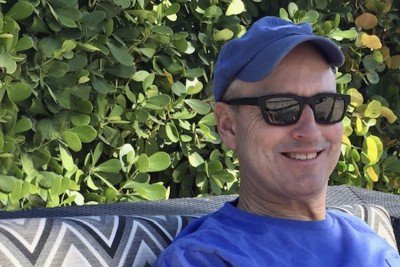The Subtle Symptoms That Led to Tom’s Leukemia Diagnosis
Tom Gibbons’s vacation plans were cut short when he was diagnosed with leukemia. He started on a clinical trial at Memorial Sloan Kettering that required him to be in the hospital for weeks. Find out how he’s doing six years later.

Tom Gibbons was gearing up for a trip to the Bahamas when he cut his fingers on his bike rack. Tom, 53 at the time, didn’t think much of it. But while the retired New Yorker was in Orlando before embarking, the wounds became infected. He also noticed sores in his mouth. He took himself to a local pharmacy, and the pharmacist recommended he go to a nearby hospital to get checked out.
“I just thought I would need a tetanus shot,” says Tom, now 60.
After getting blood work done in the emergency room, Tom got the shock of his life: He had cancer. He didn’t know what kind, but doctors immediately transferred him to the hospital’s oncology unit. He called his family for advice. His brother-in-law, an anesthesiologist in Boston, recommended he go to Memorial Sloan Kettering. Tom was comfortable with that suggestion because MSK is close to his home.
The Orlando hospital would only release Tom if he began immediate care at MSK. Tom’s sister flew to Florida to accompany him back to New York. Upon landing at LaGuardia Airport, he took a taxi straight to MSK.
Getting Answers
Tom had more blood work done at MSK’s Urgent Care Center to confirm the diagnosis. He and his family then met Ellin Berman, a hematologic oncologist who would be overseeing his care. Dr. Berman explained that Tom had a rare and aggressive form of leukemia called acute promyelocytic leukemia (APL). APL happens when white blood cells are unable to develop, resulting in a shortage of normal cells and platelets.
“Dr. Berman was very straightforward and told me what I had, how it evolved, and the treatment she recommended,” Tom says. “I felt extremely comfortable with her. I was putting my life in her hands.”
Dr. Berman thought that Tom’s best treatment option was to enroll in a clinical trial that had been successful in treating APL. It was a combination of chemotherapy and two other drugs.
“We’re always trying to improve on the care of our patients with APL,” Dr. Berman says. “Tom helped us — and the leukemia community in general — by participating in this trial, as these treatments can evolve to become the standard of care.”
Dr. Berman said the regimen would be difficult to tolerate, however. Tom would have to spend nearly 50 days in the hospital receiving medicine. But he was quick to agree to the plan.
“I didn’t hesitate whatsoever,” he says. “They said they had seen excellent results and thought it would be the best course of action, so I was on board. It was an easy decision.”
“Whatever It Takes”
The seven weeks of treatment were more difficult. Tom lost his hair, his appetite, and 30 pounds. He was regularly nauseous and had severe headaches. He developed additional mouth sores and had fluid buildup in his fingers and toes. But Dr. Berman helped him stay motivated.
“We had to work toward getting him free of leukemia,” Dr. Berman says. “Our approach was whatever it takes to get you there, we’ll do. He was perfectly compliant with that, and not without his sense of humor. He was a real pleasure to treat.”
Tom credits his tolerance of the treatment to his sheer will to live — and his care team’s encouragement.
“I was going to do whatever it took to get out of there and be healthy,” he says. “When one of the nurses said, ‘We can treat people like you,’ as bad as everything was, it was just what I wanted to hear. I clung to that hope.”
And it paid off. After nearly two months, Tom had no evidence of disease and was discharged from MSK. Dr. Berman was very encouraged by his progress. But he wasn’t out of the woods yet: He still had to have chemotherapy five days a week, on an outpatient basis, for nine months as a precaution to fend off any micrometastasis. These are rogue cancer cells that can linger after treatment.
Tom was happy to be back in his home, and after more chemotherapy, he was finally in the clear.
Tom Today
Six years after completing outpatient chemotherapy, Tom continues to have no evidence of disease. He comes back to MSK every six months for checkups and loves to golf, ride his bike, and travel. He is very grateful that his family recommended MSK for treatment.
“Since there are only about 1,000 cases of APL each year in the United States, people really need to be treated at hospitals that are familiar with the disease. That’s why I went to MSK,” he says. “It was a rough few months, but everyone I met — doctors, nurses, technicians, the people who served me my meals, the cleaning staff — was so kind, caring, and compassionate. This made all the difference in the world.”
Dr. Berman says that Tom “always lights me up” when he comes back to MSK. She is thrilled that he is able to resume the lifestyle he was leading before cancer. Three years after his diagnosis, Tom finally took that trip to the Bahamas.



